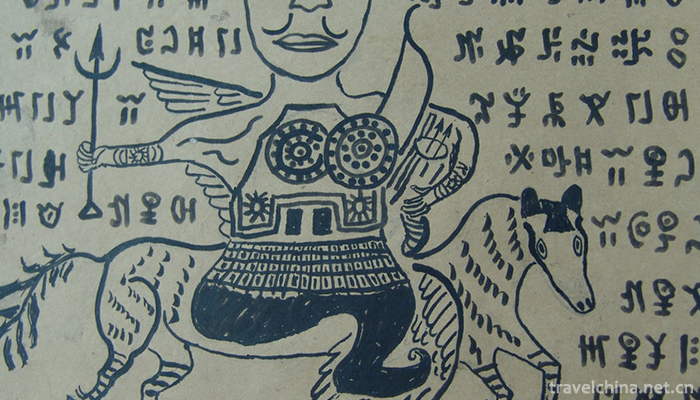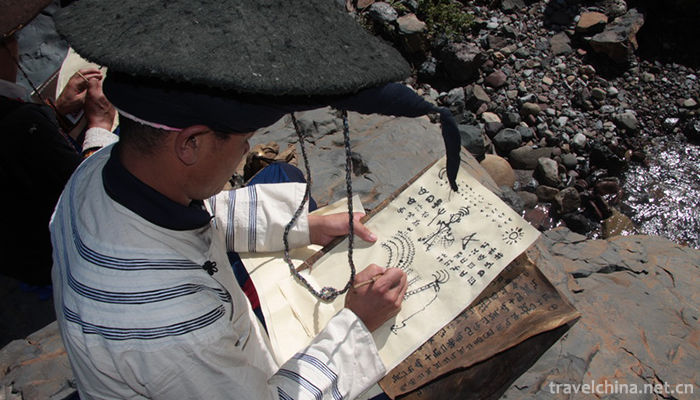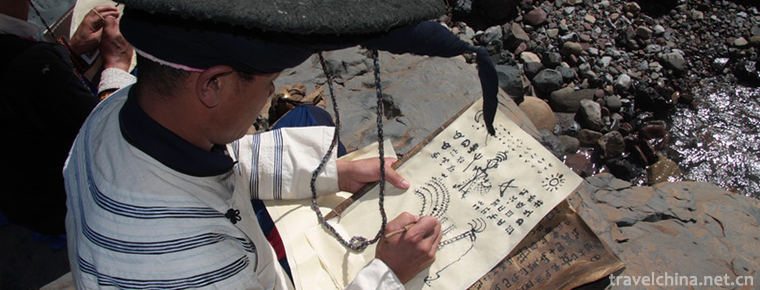Bemo painting
Bemo painting
Project Name: Bimo Painting
Bimo Painting of the Yi Nationality is a kind of picture on paper or animal skin, bark, bamboo slips, stone, wooden boards and other carriers painted by Bimo, a priest of the Yi Nationality. It is an artistic system that narrates stories, shapes images, expresses emotions, reflects historical life, expresses aspirations and aspirations in the form of mutual cooperation between painting and writing. It is the "living fossil" of the ancient painting art of the Yi Nationality and has distinct people. Ethnic characteristics.
Bimo painting is one of the important plastic arts used in Bimo's literature and Bimo rituals, with a long history. Bimo was a tribal chief of the Yi people in the ancient period of "the unity of politics and religion". Later, Bimo gradually transformed into a priest specializing in sacrifice, history recording and divination, and was also the only person among the Yi people who mastered the systematic primitive painting art and writing. According to The Origin and Development of the Yi Nationality, as early as in the Ai-nurturing era, "Ai-nurturing the roots of women, spread to Lou Shiying... Think of knowledge in your heart, speak knowledge in your mouth, and write knowledge in your hand. Linked to brocade, brocade is full of flowers. Books are like sunshine, and pictures are like moonlight. Supo Meihai Bitter Su, a classic of the Yi language, contains: "Tang Zhi used the Yi Sutra to celebrate sacrificial rites. When the forehead collapsed, Hou Rong came to chant sutras (Tang Zhi was the leader of the Yi people in ancient times). "Huayang National Chronicle? Nanzhong Chronicle" contains: "Zhuge Liang paints the map of heaven and earth, sun and moon, monarch and minister, City Hall first; Shenlong, Longshengyi and ox, horse, camel and sheep secondly; then the principal of the painting department rides horseback covers and patrols on a shirt; and paints the portrait of sheep bearing wine and carrying golden treasures. To bestow it on the barbarians is of great importance. Also dialysis out the shadow of Bimo's painting.
Liangshan bemo literature "Bi Bu song Bi" also contains a generation of bemo master, Wei lerqiong, "intelligent, intelligent, intelligent, intelligent, skillful, inheriting the past and learning, to extract the essence". More than two thousand years ago, the Yi society in Liangshan entered the agricultural era from the hunting era. At that time, Bimoti Bichamo and Hao Bishchu carried out a famous oral debate on the reform of the "ritual system" in the history of Yi culture. According to legend, there were pictures and literary records written in Pizhang at that time.
Bimo paintings are distributed among the Yi people in Sichuan, Yunnan, Guizhou and Guizhou provinces, with Liangshan as the focus. Within the scope of Liangshan, Meigu, Zhaojue, Butuo and other Yi districts are the representatives, especially Meigu County, which is well-known at home and abroad for its large number of Bimo people, profound cultural accumulation, unique style, rich content and diverse forms.
Bimo usually makes pens from bamboo and wood chips, dips in ink made from soot of cooker dipped in animal blood, draws on paper or wood board, and does not draw draft, calms down, does not carve at one go, the lines are simple and refreshing.
Bimo paintings are usually divided into two categories: illustrations on Bimo documents and graphic symbols on boards and slates.
One is the illustration in the literature.
Documentary paintings always match words, mostly on the title page or the last pages. Paintings and corresponding words are used to express thoughts and emotions. They mostly reflect the evolution of heaven and earth, the demons and demons of ancient heroes, the celestial phenomena such as platoon in ancient wars, sun, moon and stars, the migration route of Yi ancestors, animals and plants, and even the exotic world. Devils and ghosts, etc.
Liangshan Bimo's paintings use the artistic method of "looking up at the sky, looking down at the earth, looking down at the birds and animals, approaching all bodies and taking all things far", and use the artistic method of looking up at the heaven and the earth, and traveling too empty to understand with the heart, freely organize the "images" in the heart, and by abstract means, abandon the contents that the eyes can see but are regarded as unimportant, while the eyes can't see them. What is considered essential, however, will be described in detail. Grasp the essential feature of "bone", and give up its outline, the "bone" image of the paintings.
The objects in the universe, lofty and mysterious, are often the sacred things most likely to arouse the reverie of the ancients, which occupies a very important position in Bimo's paintings. The Yi people often draw the sun, moon, stars and other celestial phenomena in similar shapes. For example, the skeleton of the sun and the moon is taken in the form of a simple brushwork, and filled with "zhi" or "yi" lines or small circles along both sides of the skeleton line to show the light of the sun and the moon, and then to paint decorations; the clouds and fogs are represented by a number of symbols bent upward; the thunderbols and lightning are bent symbols to indicate haste and strength.
The painting of animals and plants embodies Bimo's style of drawing bones. Taking the shape of a chicken as an example, a curve is used to represent the body, linking the head, wings, legs and feet and tail. It can be said that the image of a chicken is extremely simple. In contrast, in each part, more short lines are used to describe the crown of "nine" conodonts, the claws, wings and tail of five fingers, and even a point and a small circle are used to mark it. Chicken's eyes and nose. Similarly, the boa constrictor or Phoenix Painting only uses simple lines to draw its "bones" in the body part of its trunk, while it is decorated with countless small circles or semicircles or dots. In contrast, it highlights its head and tail with more pen and ink to highlight what is considered to be an important part. Draw horses and cattle, highlight horns and tails, grasp their respective characteristics, but also from the function of distinction, that is, horseback loaded with people, cattle pulled plough. A snake is a simple brush shape of a snake. A fish draws only fish bones, a painter draws the skeleton structure of a human being, and a tree draws several branches, which are the same as the ancient Yi characters.
In Bimo's paintings, the image of Zhigearu, the ancient hero of the Yi nationality, is the most common and prominent. Bimo people symbolize the four copper pillars that support the sky in a square shape. They also symbolize the four sides of the earth. They show the magnificent momentum of Zhigear's footsteps on the earth and the sky above his head. The sun and moon symbols painted above Zhigear, the bows and arrows, bronze net pockets, iron forks and copper hammers on the left and right sides, and the flying horses with wings on the bottom, are similar to the images of Zhigear in the scriptures: "The left eye is like the sun, the right eye is like the moon..." The description corresponds to the hero Zhigear's many legendary heroic deeds, such as subduing Raytheon with a copper hammer and a copper net pocket, arrowing the sun and the moon with bows and arrows and iron forks, and subduing a man-eating Pegasus.
The second is the pictures on the boards and slates.
Bimo's paintings on wooden boards have a fixed formula for drawing the world and the world. The symbol with a vertical line inserted in the middle of the top three horizontal lines represents the sky, and the symbol with three arcs drawn at both ends of the next horizontal line represents the earth. Then the symbol of the sun and moon is drawn. The moon is usually in the shape of a half-moon, together with some broken lines and dots or small circles, the sun is drawn into several circles plus a number of dots, and then the dots arranged in multiple rows represent the stars and the three small ones or so. Half-arc symbols form "fog" and so on.
The main stone paintings are hail-proof, deforestation-proof, God map and so on.
Bimo's literature drawings are also characterized by the use of military array and star image bits, which are usually attached to the end of each volume of literature. The drawing method is simple and clear. If a star is painted, only a little is drawn, and three points are drawn for Samsung. The military array drawings are based on the layout pattern, with several vertical lines representing the fork-and-axe array, the chief painter a circle of representatives, and the geography of mountains and rivers painted according to the characteristics. Small stones, small trees, water pockets and other simple symbols, and in the corresponding parts of the text, the momentum is magnificent.
One is utilitarianism and belief. Bimo painting is the product of animism and other local beliefs of the Yi people. It provides textual evidence for Bimo rituals and enhances the effectiveness of the rituals. It is mainly used in various Bimo rituals. It has obvious utilitarianism and belief.
Second, primitiveness. Bimo Painting of Yi Nationality focuses on highlighting the "skeleton" framework, emphasizing spiritual observation, highlighting the use of "lines" and simple colors in the picture, and pursuing the effect of plane and decoration.
Third, uniqueness. Bimo's painting is incomplete in terms of distortion, weirdness, mystery, emptiness, fracture, incompleteness and even "ugliness". This naive, simple, natural, mysterious, frank, rigid and energetic painting form reveals a unique beauty of national rhythm and rhythm.
Fourth, the unity of painting and calligraphy. Bimo's painting always embodies the ancient tradition of "the unity of painting and calligraphy". Every painting must be equipped with words, which can be seen everywhere with textual explanations. In many paintings, Bimo also shows the characteristics of "painting as well as character".
1. Historical value. Bimo painting has irreplaceable value for the study of the origin and development history of human primitive painting art and writing. In the long history of thousands of years, painting and writing have evolved separately, and the writing system has developed from the original pictograph to the complete "six-book system" of referring to things and understanding. Bimo's painting art has always retained the appearance of the original era, which is of great value to witness the ancient art civilization of the Chinese nation.
2. Cultural value. Bimo painting is inherited in the Bimo group of the Yi nationality with its unique ritual, and spread in the folk of the Yi nationality through ritual. It has a very wide acceptance group and high research value. With the further study of Bimo culture, more and more attention has been paid to it.
3. Art value. Bimo's painting, with its unique method of "looking at things and taking images" and pointing directly to the "bone" of spirit, embodies the naive, simple and natural charm. It is this mysterious, straightforward, stiff and powerful painting form that reveals the rhythm and rhythm, reflects the precious exploration spirit of ancient human beings, and creates the unique aesthetic world of the Yi people with its special style. It has become a unique cultural landscape in the multi-culture of the Chinese nation, especially in the "Tibetan-Yi Corridor", which provides a reference for the ancient art and civilization of modern painting.
4. Social value. Bimo painting is the main link between national identity and psychological identity among members of the Yi nationality. It has important practical significance for the cultivation of national self-confidence and emotion, strengthening national unity and building a harmonious society. It also plays an irreplaceable role in providing traditional art education mode.
Provincial level
Qubi Awu, the provincial inheritor of Bimo painting, male, Yi nationality, was born in 1946. He lives in Yomuhong Village, Niuniuba Township, Meigu County. He is the 29th generation descendant of Yang Gusubu in Quni Department. He is a well-known hereditary Bimo. The inheritance spectrum of Qubiau's works is as follows: Yang Gusuub-Submann-Man Ma'an-Maandura-Durayodi-Yodhiyol-Yor'azu-Azupovu-Povunija-Nirvaisen-Vincent-Vincent-Gaarga-Algo-Ergobija-Bija's deputy-deputy-deputy-Ala-Arajot-Yotbio-Biero-Loyolaja-Raja. Bo-Ahuojidu-Kitukbi-Kibijiti-Kibizu-Bizukel-Kernitu-Nituawu-Tribiawu.
Qubiawu was smart, lively, self-confident and inquisitive when he was three years old. He learned from his father Kernitu when he was five years old. He could recite simple scriptures under the road when he was seven years old. He could conduct simple rituals independently when he was eleven years old. In his life, although his father let him go on the Bimo road, is his own enlightenment teacher, but really make him become a famous Bimo, is Ma Zi Sha Bimo. At the age of thirteen, when he was successful in his studies, he met with the reform of the people and the death of his father, and gave up a period of time to finish his studies. Later, I met Mabimo. With his guidance and help, I started my own studies and made rapid progress. At the age of 21, I entered a high-level ritual of sending souls back to my ancestors, i.e. Nimu Chobi, and later I traveled to Leibo, Zhaojue, Xichang, Ebian and Ma Bian. Up to now, 45 ceremonies have been sent to the ancestors, 42 to the pig scapula ceremony, and more than 30 to the apostles. Among them, "Nobi" 8 people, "Qubi" more than 20 people, among many apprentices, several have become famous Big Bimo. He is the best person to do the scapula ceremony, and the high level "nemu CuO Bi" is also outstanding. In his career, he has cured many patients, such as rheumatism, facial paralysis, quadriplegia, psychosis, etc.
Qubiawu has over 180 volumes of Bimo literature, most of which are ancestral and some of which are collected by himself. He regards Bimo literature as a treasure and generally does not give it to others easily. In recent years, with the continuous attention of the Yi Bimo culture, in order to support the development of this broad and profound Bimo culture, he has donated most of the literature to the Bimo Research Center of the Yi Nationality in China, participated in many academic seminars on Bimo culture of the Yi Nationality, and was awarded the title of "Advanced Individual Collecting Bimo Documents" by the People's Government of Meigu County in 2004.




-
1.Shantou beef ballTime 2018-11-02
-
2.Go BelieveGoubuli baozi
Goubuli steamed bun is a snack made of flour, pork and other materials. It was founded in 1858 (Xianfeng period of the Qing Dynasty).
Time 2018-11-14 -
3.Fuzhou national forest park
Fuzhou National Forest Park (also known as "Fuzhou Botanical Garden") is the first National Forest Park in Fujian Province, one of the ten National Forest parks, and one of the six 4A scenic
Time 2019-01-12 -
4.Huguangyan Scenic Spot
Huguangyan Scenic Spot is located 18 kilometers southwest of Zhanjiang City, the southernmost part of the mainland of China. It is called "natural yearbook" of earth and geological science b
Time 2019-01-16 -
5.Old city of Kashi
The old urban area of Kashgar City in Xinjiang is like a living cartoon of Xinjiang Uygur folk customs. The old urban area of Kashgar is located in the centre of Kashgar
Time 2019-01-29 -
6.Eight Delicacies Rice
The traditional name of Ningbo is Laba Festival Food. It is made from raw materials such as glutinous rice, bean paste, jujube paste, preserved fruit, lotus seed, rice kernel, longan, sugar and pig fa
Time 2019-03-25 -
7.Fengxiang Wood Engraving New Year Picture
Woodblock New Year Painting is a traditional folk art form with a long history in China. Fengxiang Woodblock New Year Painting is a major school of Chinese traditional folk New Year Painting.
Time 2019-04-29 -
8.Huatuo Wuqin Opera
Huatuo Wuqin Opera is a set of guiding techniques compiled by Huatuo, a famous physician in the late Eastern Han Dynasty, according to the principles of traditional Chinese medicine,
Time 2019-05-04 -
9.Quanzhou North Pipe
Beiguan, also known as Beiqu, Xiaoqu, Quzi, is a kind of traditional folk silk and bamboo music widely spread in Quangang District, Quanzhou City, Fujian Province. China's Beiguan is now only distribu
Time 2019-06-11 -
10.Four strands
Four-strand string, also known as four-strand string, two-strand string, five-tune string and five-tune tune tune tune, is one of the ancient traditional local operas in China. It originates from Julu
Time 2019-06-16 -
11.Appreciation of short sleeve cheongsam
In the late summer and early autumn, the weather is chilly in the morning and evening. As long as you put on some thin shawls, you can wrap some cloth shawls and tighten them on your chest.
Time 2020-12-11 -
12.Guangan location
Guang'an City is located in the east of Sichuan Province, with the geographical coordinates of 30 ° 01 ′ - 30 ° 52 ′ n, 105 ° 56 ′ - 107 ° 19 ′ e, 134.5 km from east to west, 93.6 km from north to south, from Linshui county to Dazhu County of Dazhou City, from
Time 2020-12-19